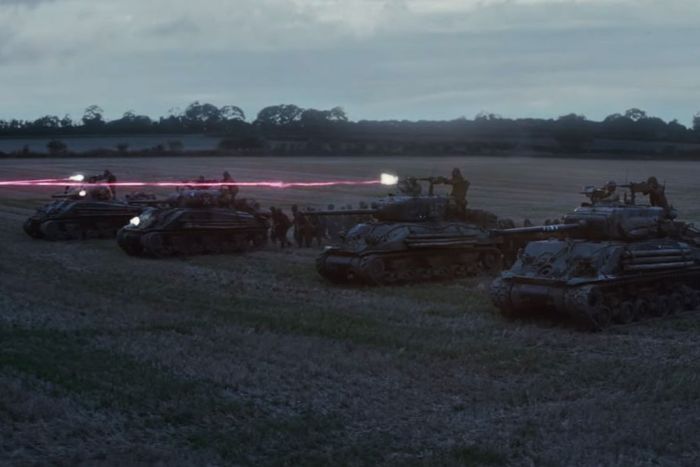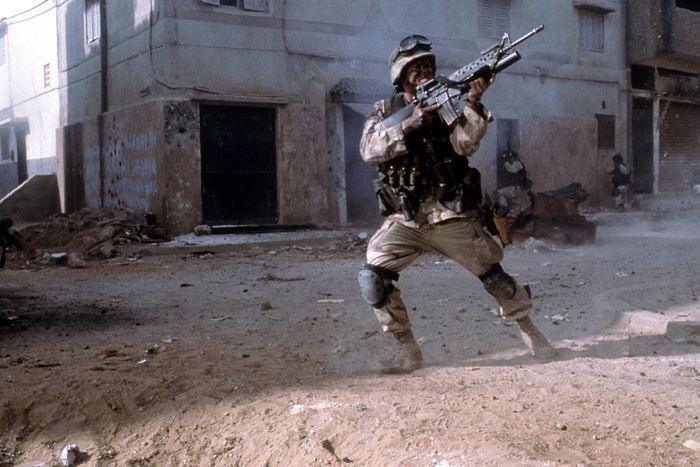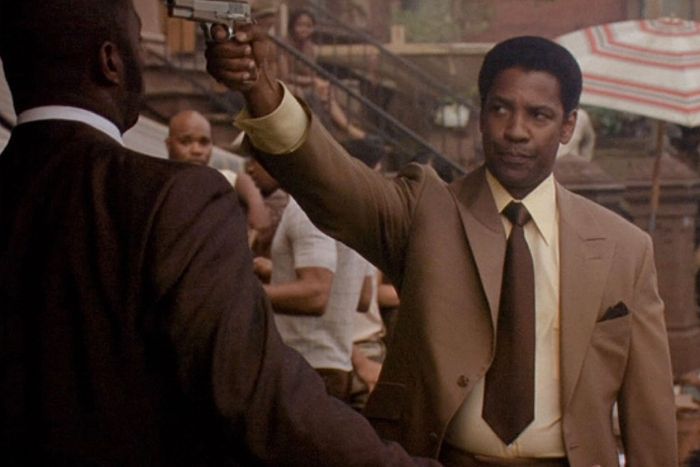
The breakthrough came in a hail of gunfire on the 2013 Brad Pitt–starring World War II tank epic Fury. Writer-director David Ayer — whose artillery-heavy filmography includes Suicide Squad, End of Watch, and Netflix’s Bright — had been consumed with properly rendering tracer fire, those luminous bullets that help soldiers visually follow the flight of ammunition in battle, onscreen. But the myriad safety risks, high costs, and production obstacles associated with blocking dozens of shots using live rounds made filming an actual tracer shoot-out all but impossible. “In kind of an obsessive manner, he knew that when the Germans were firing this kind of gun, every sixth bullet was green, and when the Americans were firing that gun, every fifth bullet was red,” recalls Fury’s visual-effects artist, Beau Janzen. “He wanted to bring this supreme level of accuracy to everything.”
The solution turned out to be as inexpensive as it was hazard-minimizing. After extensively studying the drifting trajectory of tracer ammo, effects technicians used compositing software that could not only convincingly simulate the travel of glowing rounds but also add muzzle flash and shell ejection to prop gunshots during postproduction, vastly reducing both the cost of filming the scene and the dangers faced by actors, stunt performers, and crew members while shooting it. In the resulting scene, laserlike zips of gunfire convincingly ricochet off tanks and past soldiers’ heads. “Visual effects are not just for the big illusion; they are also for making things safer,” Janzen says. “It makes you question how many decisions filmmakers are making these days because ‘that’s kind of the way we always did it,’ as opposed to, ‘Here are new options and different, better, safer ways of doing this.’”
In the weeks since cinematographer Halyna Hutchins was killed and director Joel Souza was injured in a live-gun mishap on the set of the indie Western Rust, such questions have dramatically gained in urgency. Alec Baldwin — Rust’s star-producer who discharged the Colt .45 authorities now suspect was loaded with a live round — tweeted, “Every film/TV set that uses guns, fake or otherwise, should have a police officer on set, hired by the production, to specifically monitor weapons safety.” Stars including Lena Dunham, Anna Paquin, Sarah Paulson, and Olivia Wilde have supported an online petition banning the use of real firearms on sets that has grown to over 115,000 signatures. Mare of Easttown director Craig Zobel tweeted that using real guns in an age of computer sophistication was an “unnecessary risk,” and a group of prominent cinematographers issued an open letter calling for immediate action from union leadership, producers, and lawmakers to “BAN all FUNCTIONAL FIREARMS on set.” Earlier this month, Hollywood’s top action draw Dwayne Johnson pledged to stop using live firearms on all projects made by his company Seven Bucks Productions. And at a time when Santa Fe County Sheriff’s Office investigators are still determining the logistics of the Rust tragedy, California state senator Dave Cortese is moving forward with plans to introduce legislation restricting the use of both live ammunition and weapons capable of firing such rounds on sets.
But entertainment-industry consensus regarding the abolition of real guns remains elusive. A growing number of showrunners, such as those for the superhero series The Boys and the cop procedural The Rookie, have opted to ban guns from their sets and gird for further reform of their industry. But top-tier purveyors of filmic firearm mayhem like Michael Bay, Fast & Furious director Justin Lin, John Wick’s Chad Stahelski and David Leitch, and Kingsman director Matthew Vaughn have given no indication they’ll be trading real steel for prop plastic pistols anytime soon. (Stahelski and Leitch declined to comment for this story. Representatives for Bay, Lin, and Vaughn did not respond to requests for comment.) In a recent interview with Vulture, House of Gucci and Black Hawk Down director Ridley Scott indicated his unwillingness to discontinue the use of functional weaponry. “Are you kidding me?,” he responded when asked if he would consider banning live ammunition. “Black Hawk Down?
“No live round should ever be near a set,” he added, referencing a report that the Rust crew had used the gun that killed Hutchins for live-ammunition target practice, known as “plinking.” “If you’re doing target practice at lunchtime, somebody should get fired.”
In an open letter last month, a collection of leading on-set armorers and weapons masters working within the motion-picture industry — the individuals specifically responsible for gun safety during film and TV shoots who are entrusted with keeping live weapons secure as well as personally loading and distributing the firearms to actors on sets — offered an impassioned defense of the “production value” that genuine ammunition provides, insisting that prop guns and animated muzzle flash will never be adequate substitutes. They took pains to point out that there have been a total of three deaths due to firearms on film sets since 1984, an exemplary safety record that stands in contrast to 23 on-set deaths attributed to construction, 23 involving stunts, and 30 in aircraft-related accidents over the past 20 years, according to unspecified “film-industry statistics.” Firearms are “ubiquitous on film sets and have been since the birth of our industry over 100 years ago,” they write, and the loss of life on the Rust set was “likely the result of incompetence and inadequate use of professionals who serve as the gatekeepers to the film industry’s safety protocols and standards.” They ultimately see the industry’s quick response to ban real weapons as “misguided” — misaligned with creative expectations after decades of refinements in simulated gunfire.
“A car accident at an intersection does not require elimination of vehicles,” the letter reads, “it requires adherence to the rules of the road and education and implementation of those rules among all participants.”
John Fox, an Australia-based armorer who has racked up dozens of movie credits over the past four decades, including Killer Elite, Ghost Rider, and Animal Kingdom, describes the early days of movie gunplay as “more informal.” “In the early days of gangster movies, they did actually fire machine guns at buildings and damage the buildings,” Fox says. “The actors at the time basically said, ‘We don’t want to be in the scene.’”
Ron Licari, a veteran armorer who has worked on many of the biggest tentpole event movies coming out of Hollywood (Captain America: Civil War, Mission: Impossible III, Kong: Skull Island, and Jumanji: Welcome to the Jungle), recounts a similar history. His first year on the job was a pivotal one — it was 1984, the year actor Jon-Erik Hexum died by an accidental self-inflicted blank-round gunshot to the head while simulating Russian roulette on the set of the TV series Cover Up. “You transported the weapons to the set, and you made sure they weren’t walking off the set,” Licari says of the job requirements before ’84. “But then the industry started to shift. Because after the Hexum incident, the prop masters all started getting together, going, ‘Look, I’m dealing with props. I got 12 actors on the set. I got watches and food to deal with. How do you expect me to keep an eye on handguns as well?’ That’s when it became, ‘Hey, we need guys that all they do is focus on the guns.’”
Over the intervening years, certain aspects of the on-set handling of live firearms have remained constant. The top priority for armorers was and will always be safety; according to Safety Bulletin #1, a list of recommendations for precautions with firearms drafted by an industrywide labor-management safety committee, “‘Live ammunition’ is never to be used nor brought to any studio lot or stage,” let alone onto an actual set. Armorers remain in “constant control” of weapons, renting them from vast prop clearinghouses (such as Independent Studio Services, which boasts an inventory of 15,000 live firearms), testing them before they arrive on any production premises, and sealing them inside steel lockboxes when not in use. They supervise the blank ammunition (which is also tested) and carefully check every round before it is inserted into a gun’s magazine. They keep guns empty for rehearsal and load them when the cameras roll, handing them to actors with a reminder to stick with rehearsed action choreography and never to improvise.
But as the use of firearms onscreen has evolved, so have the responsibilities of armorers beyond the more obvious safety concerns. “We get scripts; we break them down. We have discussions with directors about what firearms are needed for the show, per character, and we gather those weapons,” Licari explains. “We have show-and-tells with directors and then we rent those weapons for the run of the show. If we’re reading those scenes and we go, ‘Oh, wait, we got a guy running down an alleyway shooting back at the cops. Okay. Well, now we got to go out and look at the location. What are the parameters? What’s our safety distances?’ And maybe because of the location, there will be sound ordinances. It’s going to be a night shoot, so we can’t do full loads. Only quarter-loads because it’s not as loud. There’s a lot that we as armorers have to decide upon.”
Despite the growing list of job responsibilities for armorers, mishaps like the one on the Rust production are exceedingly rare. The last on-set shooting death occurred in 1993, when Brandon Lee, son of the late martial-arts superstar Bruce Lee, was accidentally killed by a .44-caliber slug while filming the action-fantasy The Crow. Hence, Fox feels sweeping reforms to ban real guns are unnecessary. “You don’t take anything on set that you haven’t tested before you got there to see that it’s in safe working order,” he says. “If you’re firing blanks on set, you need to test those blanks to see what’s going to happen when the gun fires, how much gasses will come out of it. Is there much smoke? Are there a lot of particles of gunpowder that actually don’t catch fire in the gun and exit the gun as a little particle?”
The hazard presented by those particles, of course, is that they could wind up flying into the eyes of actors or mangling an $80,000 camera lens. “The testing is so simple,” he continues, elaborating on the ways in which they determine safe distances for cast and crew to position themselves during shots. “You just put up some cardboard boxes, stand ten feet away from it, and fire at the boxes to see what happens. And if nothing happens, you walk two feet closer and you do it again until you get to a point where you say, ‘I can see little particles of gunpowder here.’”
Most discussions of abolishing functional firearms these days land on their go-to replacement: airsoft guns. These are technically toy replica weapons that display some of the characteristics of real guns, such as a limited recoil (the kickback a shooter feels when a bullet is discharged), operating on a valve-released system of compressed “green gas.” They are much lighter than real guns, and they don’t emit any muzzle flash or the thunderous 130-to-150-decibel blast of a working firearm, requiring animated bursts of fire and sound to be added in postproduction. But they are increasingly coming to be viewed as a safe and sane alternative to firing blanks, which still have the capacity to kill or maim if discharged in close quarters.
Ahead of the Rust tragedy, filmmaker Ben Rock (Video Palace, Alien Raiders, The Blair Witch Project) had been using his moviemaking podcast, Video Palace, to advocate for stricter Hollywood gun regulation and is now a firm advocate of outlawing live guns in favor of airsofts. Having filmed movie and TV projects with both types of weapons, he points to the inefficiency and enormous expense — especially for smaller independent productions — that necessarily accompany having live firearms on set. “My producer once told me, ‘Every time you want someone to fire a gun, you’ve just kissed away 30 minutes in safety meetings,’” Rock says. “Earplugs are passed out, and everyone has to wear them. Plexiglass is put up by the camera if it’s firing anywhere near the camera. Plywood is put up around stuff. It just eats time. It’s not in directing. It’s not in working with the actors. It’s not in getting a better performance. It’s just in getting things safe.”
As a second-unit director on the Crackle TV series Chosen, he was first exposed to airsoft guns’ clear upsides. “They cannot fire bullets. They are pellet guns that look just like the real thing,” says Rock. “They don’t give you the full recoil you would get from firing a gun with a blank. But the beauty of it was we could have Rose McGowan running around and shooting and not being afraid anything was going to happen. There’s no safety meeting to be had because you’re not making a big loud noise. No particles are flying out the front. And the only real accidents that could happen are the same accidents that could happen if you dropped it on something and it broke.”
Janzen — the Fury visual-effects artist who also supplied VFX to such films as Man of Steel and Speed Racer and who won an Emmy for Best Visual Effects on HBO’s Westworld — points out that in the digital era, the technological barrier to animating things like muzzle flash and shell ejection during postproduction is so low and so inexpensive even the tiniest shoestring indies can afford it. “I don’t believe that putting in muzzle flashes — even a lot of muzzle flashes — is necessarily cost prohibitive for a small budget,” says Janzen. “Everything is digital now. So it’s not as hard to pull the plates. It used to be, ‘Oh, it’s film. We have to scan the film, make it digital, send it to the artist, and put it back on film.’ And there are many [VFX] studios that are less expensive. I mean, if you look at pretty much any movie nowadays, they all have visual effects in them.”
But armorers like Licari and Fox are quick to point out that airsoft guns come with limitations, too: They break easily, and replicas of many vintage weapons — say, the muzzle-loading firearms of the 1840s or the cartridge guns of the 1870s — are simply not manufactured as airsoft. And in an era when modern moviegoers demand ever more double-barreled verisimilitude onscreen, the armorers say having an assistant director yell out the word bang on set is no substitute for the sound of real gunfire as a prompt for naturalistic battlefield acting.
More crucially, Licari — who used airsofts for a bridge shoot-out sequence on the Netflix thriller Extraction — says the pellet shooters are in certain ways less safe than using a live gun with a “solid-plug load”: a barrel completely blocked from emitting any type of projectile. Solid-plug weapons were extensively used during the John Wick films’ “gun fu” scenes, in which characters shoot one another at close range. With nothing capable of coming out of such guns’ barrels, there is effectively zero possibility for the kind of blank-round mishap that resulted in Hexum’s death. “You could literally shoot somebody point-blank with a solid-plug gun,” says Licari. “You get the slide movement, and you get a shell ejection. But there’s no muzzle flash. I don’t like airsofts because I don’t have a complete way of checking the barrel. And even with an airsoft, I’m still expelling something out of the front of that gun. I’ve argued with camera operators and producers and actors about how they feel much safer with an airsoft over a regular firearm. But the point is, ‘Hey, I still have compressed air coming from the front of this gun. I can still put your eye out with it.’”
Director Scott employed a solid-plug weapon for a scene in American Gangster in which Denzel Washington’s crime kingpin, Frank Lucas, unexpectedly executes a drug dealer played by Idris Elba. “The gun I used was solid, but it’s got a little hold in the end. But you can pull it back, so there’s recoil. You pull the trigger, it goes bang, and that’s it. There’s no bullet. There’s no blank. There’s nothing. Put a sound on it afterward,” Scott recalled, underscoring the significance of having a real weapon on set for his actors. And Scott says he told Elba, “When he puts the gun to your head, you taunt him. Lean on the gun and say, ‘What are you going to do — shoot me, Frank?’ And Frank turns away and just pulls the trigger. Well, there’s a recoil. Idris fell like a stone — thought he’d been shot in the head!”
Armorers, a small but impactful group of several dozen people in North America and approximately 100 more individuals working on mainstream movie production across Europe, Australia, and New Zealand, are clearly spooked at the prospect of a functional-weapons ban that they believe will effectively decimate their profession. But industry insiders contacted by Vulture say it is difficult to envision a filmmaking future in which, say, a megabudget James Bond production is legally forbidden from using live firearms for its spectacular shoot-outs. Even though New Mexico governor Michelle Lujan Grisham has signaled that her administration could ask lawmakers to strengthen film safety guidelines in the state in light of the Rust disaster, a more likely outcome, the insiders say, is that certain actors, showrunners, and directors will continue to lobby against real weapons on sets until the issue recedes from headlines.
Writer-director Rawson Marshall Thurber, for example, made it clear that he used airsoft weapons during the filming of Red Notice, Johnson’s latest Netflix film, co-produced by Seven Bucks Productions. But he also defended the practice of using live guns. “I do think there is value in using blanks on set,” Thurber told Insider. “Both from a performance and photographic standpoint. I think actors perform differently when there’s sound and light coming from the weapon.” He added, “Maybe there’s a way to make the baseline be replica weapons, and if you need or want live firearms on set that there’s a special waiver or special approvals that have to be handled.”
While battle lines surrounding a proposed ban on functioning guns on movie sets remain blurry, the one thing people on all sides of the debate agree upon is that active ammunition will never be welcome near a camera. When asked how live rounds could have made their way onto the Rust set, Fox remained perplexed. “I have no idea,” he says. “It’s appalling. They should never be on set.”







